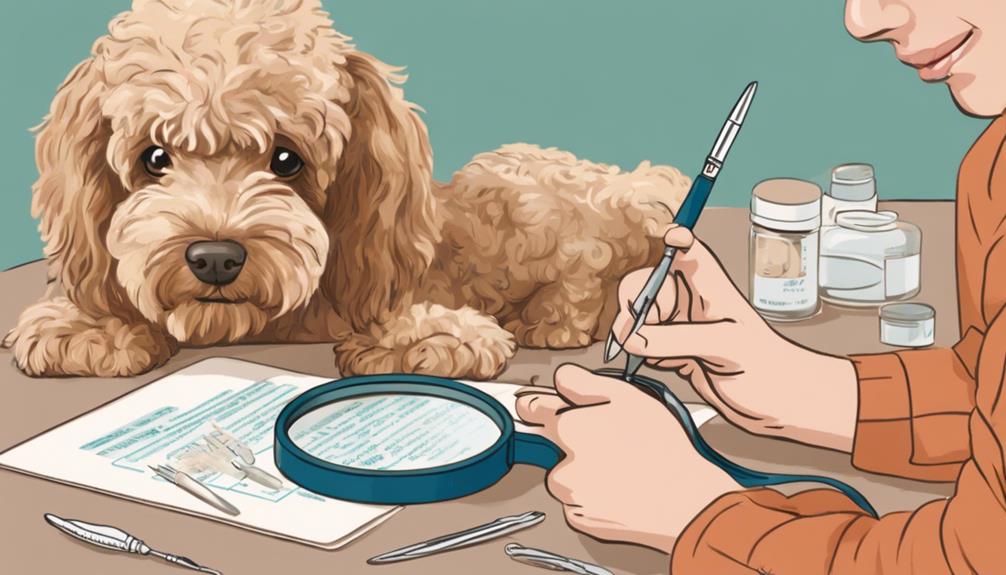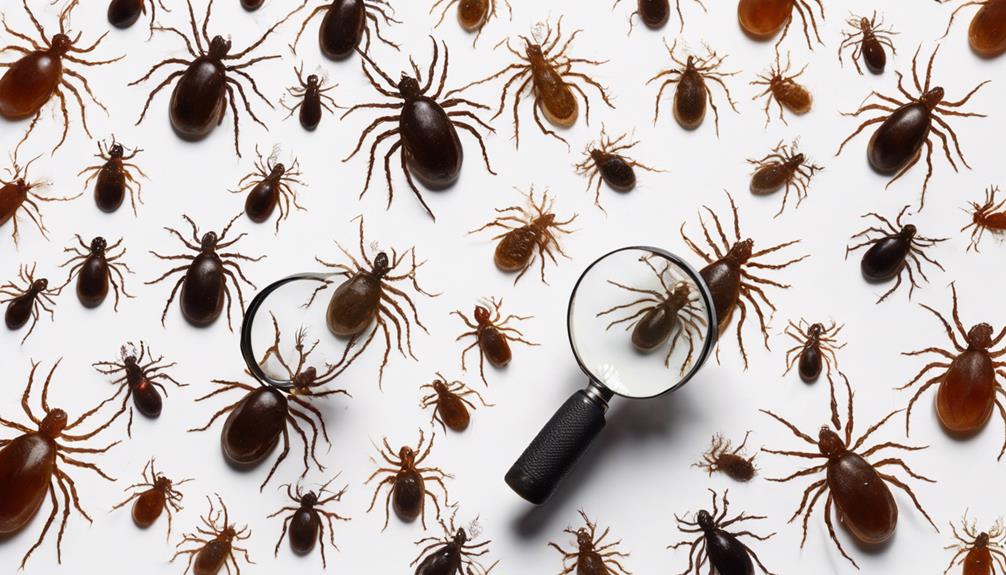To check your Cockapoo for ticks, first identify the tick-prone areas of your dog: ears, toes, collar, tail, and the groin. Use your hands to feel over their body, applying slight pressure to detect any bumps or irregularities. Your essential tools should include tweezers, a magnifying glass, and gloves to properly handle and inspect potential ticks. Incorporate tick checks into your regular grooming practices, using a fine-toothed comb to help spot tiny ticks. A systematic and thorough tick check is the key to early detection and risk reduction. More information can be revealed by delving into a more thorough routine of tick prevention and treatment.
Key Takeaways
- Establish a routine for thorough tick checks after walks, focusing on warm, moist areas like ears, toes, collar, tail, and groin.
- Use essential tools such as tweezers, a magnifying glass, and gloves during inspection, and create a calm environment for effective tick detection.
- Run your hands over the pet’s body, applying slight pressure to feel for ticks, and use a fine-toothed comb to spot tiny ticks.
- Identify different types of ticks to understand their associated risks, including American Dog Tick, Brown Dog Tick, and Black-legged Tick.
- Incorporate preventive measures like applying tick repellents on your Cockapoo’s fur weekly, getting annual tick vaccinations, and conducting daily check-ups especially after walks.
Understanding the Threat of Ticks

Ticks pose a significant risk to your pet’s health due to their potential to transmit diseases. These bothersome parasites carry a variety of tick-borne diseases, including Lyme disease and Rocky Mountain spotted fever, which can result in severe health complications if left untreated.
It’s vital to be aware of the seasonal tick activity in your region. In most areas, ticks are most active during the warmer months, typically from March to November. However, they can be present all year round in milder climates. Being conscious of when ticks are most active can help you take proactive steps to safeguard your pet.
You’re not alone in this battle against ticks. As part of a community of fellow Cockapoo owners, it’s our collective responsibility to guarantee our pets’ safety. Regularly checking your Cockapoo for ticks, utilizing appropriate tick prevention methods, and staying informed about tick-borne diseases are critical steps in protecting them.
Prime Tick-Attracting Areas
To effectively protect your Cockapoo from ticks, it’s important to know the prime areas that these pests are attracted to. Your tick habitat exploration should focus on your furry friend’s body parts that are most prone to tick infestation. Ticks prefer warm, moist areas, so they’re often found in places like the ears, between the toes, under the collar, and around the tail area.
Understanding the tick lifecycle will also help you anticipate where they might be hiding. Remember, ticks can vary in size depending on their stage in the life cycle. They can be as small as a pinhead or as large as a pencil eraser when fully engorged.
Here’s a breakdown of prime tick-attracting areas on your Cockapoo:
| Body Part | Description |
|---|---|
| Ears | Inside and around the edges |
| Toes | Between toes and under the fur |
| Collar | Underneath and around the collar |
| Tail | Base and underneath the tail |
| Groin | Warm, hidden area |
In essence, regular checks in these particular areas can significantly lessen the risk of tick infestation. Remember, early detection is key in preventing serious tick-borne diseases. You’re not alone in this, we’re in this together.
Preparing for the Tick Check

Having understood the key areas ticks are likely to target on your Cockapoo, let’s gear up for the actual tick check process. Preparation is paramount in effectively safeguarding your precious pooch against these pesky parasites.
Your grooming essentials play a pivotal role in this process. A good pair of tweezers, a magnifying glass, and gloves are essential tools. You’ll need the tweezers for precise tick removal, the magnifying glass to spot the tiny critters, and gloves for your protection. Remember, ticks can carry diseases transmittable to humans too.
Seasonal considerations should also influence your actions. Ticks are more active during warmer months, so regular checks during spring and summer are important. However, don’t neglect the colder seasons. Ticks can survive in winter, especially indoors. Maintaining a year-round vigilance is crucial.
Lastly, create a calm environment for your Cockapoo during the check. This can involve their favorite treats or toys, and a quiet, well-lit space. The less stressed your pet is, the more thorough you can be. Remember, you’re not just a pet owner, you’re part of a community committed to the well-being of our beloved Cockapoos. So, let’s prepare thoroughly and tick those ticks off our list!
Systematic Tick Checking Technique
Your Cockapoo’s safety hinges on a systematic tick checking technique that you’ll need to master. Start by setting a routine, as ticks can be present in all lifecycle stages, from egg to adult. Regular checks, ideally after each walk in a tick-prone area, will help catch ticks early before they’ve a chance to cause harm.
Begin by running your hands slowly over your Cockapoo’s body, applying slight pressure to feel for any small bumps. Be thorough, examine every part from the head to the tail, underneath the collar, inside the ears, and between the toes. Ticks love to hide in warm, secluded areas.
Incorporate tick checks into your regular Cockapoo grooming tips. While brushing your pet’s coat, use a fine-toothed comb to help spot ticks. Remember, they can be as tiny as a pinhead, so keep a close eye out.
Lastly, if you find a tick, don’t panic. Use a tick removal tool, twisting it gently until the tick releases its grip. Never pull a tick as this can leave parts of it in the skin. Once removed, dispose of it safely. With practice, this systematic tick checking technique can be easily mastered, safeguarding your beloved Cockapoo’s health.
Identifying Different Types of Ticks

In the domain of tick identification, it’s essential to grasp that there are various types, each carrying different diseases that could potentially harm your Cockapoo. It’s not enough to know ticks exist; understanding their differences, lifespans, and the diseases they carry provides a more all-encompassing defense for your furry friend.
- The American Dog Tick: Known for their long tick lifespan, these ticks can live up to two years and are notorious for transmitting diseases like Rocky Mountain spotted fever.
- The Brown Dog Tick: Recognizable by its reddish-brown color, this tick is a potential carrier of canine ehrlichiosis and babesiosis.
- The Black-legged Tick: Also known as the deer tick, it presents a risk of Lyme disease, anaplasmosis, and other tick diseases.
Safe Tick Removal Methods
After gaining a good understanding of the various types of ticks that might affect your Cockapoo, it’s equally important to know how to safely remove these parasites to prevent any potential diseases they carry. Tick borne diseases can be severe, so timely and safe removal is vital.
Here are three safe tick removal methods to contemplate, each accompanied by a brief description and the tools needed:
| Method | Description | Tools Needed |
|---|---|---|
| Tweezers | Grasp the tick as close to the skin’s surface as possible, and pull upward with steady, even pressure. | Pointy Tweezers |
| Tick Removal Tool | Slide the tool under the tick, then twist and pull. | Tick Twister or Hook |
| Loop Tool | Push the loop over the tick, then twist and pull. | Tick Loop Tool |
Remember, don’t twist or jerk the tick; this can cause the mouth-parts to break off and remain in the skin. If this happens, remove the mouth-parts with tweezers.
To further protect your Cockapoo, consider using tick repellents. These can be applied to your pet’s skin or coat to prevent ticks from attaching. Your veterinarian can provide guidance on the best products to use.
Aftercare Following Tick Removal
Once you’ve successfully removed the tick from your Cockapoo, it’s crucial to focus on the aftercare to prevent infection and monitor for signs of potential tick-borne diseases.
- Cleanse the area: Gently clean the site of the tick bite using a mild soap and warm water. It’s important not to irritate the area further, so avoid scratching or vigorously rubbing. Afterwards, apply an over-the-counter antibiotic ointment and cover it with a clean bandage.
- Monitor your Cockapoo: Pay close attention to your pet’s behavior and physical health. Post removal symptoms such as fever, loss of appetite, weakness, lameness, or unusual behavior can be signs of tick-borne diseases. If these symptoms manifest, contact your vet immediately.
- Dispose of the tick: Don’t just throw the tick in the trash. Ticks can survive and potentially infect other animals. Instead, put it in a jar of alcohol to kill it, then dispose of it safely.
Preventive Measures Against Ticks
Taking preventive measures is your best defense against tick infestations, guaranteeing your Cockapoo stays healthy and tick-free. Remember, prevention is always preferable than cure and it starts with you, as a responsible pet owner.
Tick Repellents and Tick Vaccinations are crucial preventive tools. Tick repellents can be applied directly on your Cockapoo’s fur to deter ticks from latching on. Regularly using these can greatly reduce the risk of infestation. Tick vaccinations, administered by your vet, can also help boost your dog’s defense against tick-borne diseases.
For an easy reference, below is a simple table outlining some preventive measures:
| Preventive Measures | Method | Frequency |
|---|---|---|
| Tick Repellents | Apply on fur | Weekly |
| Tick Vaccinations | Administered by vet | Annually |
| Regular Check-ups | Conducted by you | Daily |
Regular check-ups are also essential. You should check your Cockapoo daily, especially after walks in grassy or wooded areas where ticks are prevalent. Remember, a strong community of Cockapoo owners like us is always there to help. By sharing experiences and knowledge, we can all guarantee our beloved pets remain tick-free and healthy.
Frequently Asked Questions
What Are the Symptoms My Cockapoo Might Show if It Has Been Bitten by a Tick?
Your Cockapoo might show signs of lethargy, loss of appetite, or inflammation if it’s been bitten by a tick. Regular grooming and tick prevention methods are key in keeping your furry friend healthy.
Are There Any Specific Diseases That My Cockapoo Could Contract From a Tick Bite?
Yes, your Cockapoo could contract Lyme disease or Anaplasmosis from a tick bite. It’s important you’re vigilant with tick borne prevention and familiarize yourself with proper tick removal techniques to protect your furry friend.
How Long Does It Take for a Tick to Attach and Feed on My Cockapoo?
It typically takes 2-12 hours for a tick to attach and feed on your cockapoo. Utilize tick prevention methods and familiarize yourself with tick removal techniques to keep your furry friend safe and healthy.
Is My Cockapoo at a Higher Risk of Tick Infestation During Specific Seasons?
Yes, your Cockapoo’s risk of tick infestation increases during warmer seasons. Ticks thrive in warm, humid environments. It’s important to ramp up seasonal prevention efforts, particularly in known tick habitats, to keep your furry friend safe.
Can My Cockapoo Develop an Allergic Reaction to a Tick Bite?
Yes, your Cockapoo can develop an allergic reaction to a tick bite. Utilizing tick prevention methods is essential. If you suspect an allergic reaction, seek immediate veterinary care for proper allergic reaction treatment.




